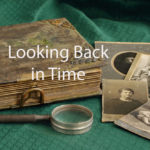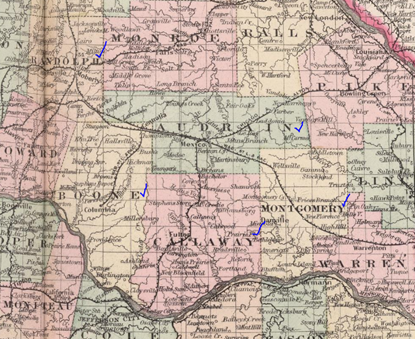
by Phillip G. Goff, GGFA Director of Genetic Genealogy
A post on the GGFA Facebook site read, “My father is Ralph E. Goff, grandfather is James E. Goff and my elusive great grandfather is Samuel Goff. By his [death certificate] his mother’s name is Mary Weddell but doesn’t know his father’s name. I have found him in the 1850 census but nothing past that.” A follow-up post pointed to Montgomery Co., MO as the location for the 1850 census.
With little to go on, the first step was to identify Samuel Goff. With the 1850 Montgomery Co., MO census as the starting point, his identity was established. Samuel G. Goff was born 24 March 1841 MO, US. In 1850, he was living with William J. (b. ca. 1820 IL) and Virginia (Beatty) (b. ca. 1825 KY) Waddle. This household seems significant as Samuel’s death certificate identifies his mother as “Mary Waddell.” In the 1860 census, Samuel was in Callaway Co., MO, immediately to the west of Montgomery. It seems likely that at age 19, Samuel was a worker on the farm of N. Tate, aged 52.
In March 1862, Samuel G. Goff enlisted in the Union army in IA, claiming as his residence Mahaska Co., IA, 200 miles north of Callaway Co., MO.

During his Civil War service, he was wounded in his left leg. Goff was mustered out July 1865 in Louisville, KY. Shortly thereafter, he married Nancy Margaret Roberts on 26 January 1866 in Audrain Co., MO, immediately to the north of Callaway County. See accompanying detail of 1886 G. W. Colton map showing counties (see blue check marks) where Samuel G. Goff lived starting in 1850.1
The next series of records, taken together, yield unexpected insight into Samuel’s origin.
Suggested next steps in the research are:
- Descendant has taken an AncestryDNA autosomal DNA test. She should consider taking advantage of free uploads to www.familytreedna.com, www.myheritage.com and www.gedmatch.com. Casting a wider net for matches is a key to success in genetic genealogy.
- Descendant should Find a male Goff descendant of Samuel G. Goff for Y-chromosome DNA testing. YDNA testing is the gold standard in tracing a paternal lineage. Big Y 700, the most advanced YDNA testing available today, can reconstruct a family tree, even when records are unavailable. The GGFA sponsors YDNA testing, including Big Y 700, for GGFA members with brick walls in their Goff/Gough lineage.
Phillip Goff is the co-author, along with Roy L. Lockhart, of The Four Goff Brothers of Western Virginia. Since 2004, he has run the Goff/Gough Surname DNA Study, which today has about 400 participants.
1 David Rumsey Historical Map Collection.
2 https://www.irish-genealogy-toolkit.com/Irish-American-history.html

Wow, you have done your homework! Actually, my brother is the one that submitted the sample, so it is from a male family member. My brother, Jim Goff, to our father, Ralph Goff, and grandfather, James Goff, and finally, great grandfather, Samuel Goff. I’m stumped by the fact that everything does point to an Irish background. My father always said he was told his grandfather was “Scotch-Irish”. Which I used to think meant one parent came from Scotland and the other from Ireland, but now I’m thinking it may have been more to do with where they immigrated from / religious upbringing? I had just thought Samuel may have been connected to the Virginia Goffs just because of the part of the family that moved to Missouri. Of course, I’m beginning to see that they all pretty much followed the same way West.
Glad this was helpful. I just looked at another Goff family a few days ago that arrived in Canada from Ireland in the early 1800s. So, there was Irish migration to America prior to the Great Famine. It’s a simple process to see if your Goff family is descended from one of the other 30+ genetically distinct Goff/Gough families. First step is to extract YSNPs from your brother’s AncestryDNA sample. Depending on what that shows, the GGFA sponsors Big Y 700 tests for members with brick walls, budget permitting. Although your brick wall is technically within reach of autosomal DNA testing, the fact that the family migrated from the British Isles where there is far less atDNA testing, may put it outside of atDNA analysis. This is no problem for YDNA, which can detect relationships going back thousands of years. If you email me offline, I am happy to help.